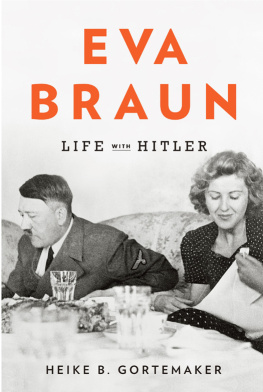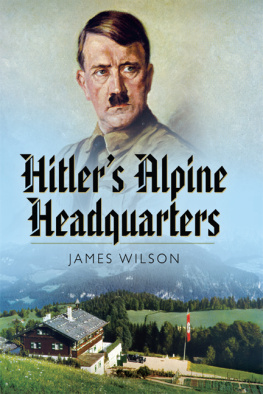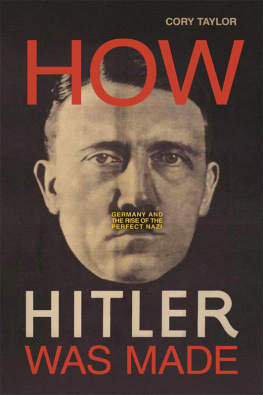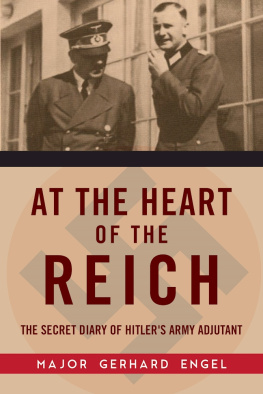
Hitlers Court
Hitlers Court
The Inner Circle of the Third Reich and After
HEIKE B. GRTEMAKER
Originally published by Verlag C.H.Beck oHG as Hitlers Hofstaat
Copyright Verlag C.H.Beck oHG, Mnchen 2019
First published in Great Britain in 2021 by
Pen & Sword Military
An imprint of
Pen & Sword Books Ltd
Yorkshire - Philadelphia
Translation Copyright Geoffrey Brooks, 2021
ISBN 978 1 52679 070 5
eISBN 978 1 52679 071 2
The right of Heike B. Grtemaker to be identified as the Author of this work has been asserted by her in accordance with the Copyright, Designs and Patents Act 1988.
A CIP catalogue record for this book is available from the British Library.
All rights reserved. No part of this book may be reproduced or transmitted in any form or by any means, electronic or mechanical, including photocopying, recording or by any information storage and retrieval system, without permission from the Publisher in writing.
Pen & Sword Books Ltd. incorporates the Imprints of Pen & Sword Archaeology, Atlas, Aviation, Battleground, Discovery, Family History, History, Maritime, Military, Naval, Politics, Railways, Select, Transport, True Crime, Fiction, Frontline Books, Leo Cooper, Praetorian Press, Seaforth Publishing, Wharncliffe and White Owl.
For a complete list of Pen & Sword titles please contact
PEN & SWORD BOOKS LIMITED
47 Church Street, Barnsley, South Yorkshire, S70 2AS, England
E-mail:
Website: www.pen-and-sword.co.uk
or
PEN AND SWORD BOOKS
1950 Lawrence Rd, Havertown, PA 19083, USA
E-mail:
Website: www.penandswordbooks.com
INTRODUCTION
The Inner Circle in the Third Reich and After
In the spring of 2010, shortly after my biography of Eva Braun was published, a gentleman whose name awoke my immediate interest introduced himself to the Munich publishing house of C. H. Beck. He was Claus Dirk von Below, son of the former wartime Luftwaffe adjutant to the Fhrer and for many years Hitlers confidant, Nicolaus von Below. The son wished to contact me, a meeting was arranged by telephone and a few weeks later we met at a caf in Munich.
We spoke at first of the relationship of his parents to Hitler and Eva Braun and about their life within Hitlers private circle at the Berghof. Almost in passing he mentioned, I grew up in that circle. According to Claus, the inner circle surrounding Hitler and Eva Braun had not broken up after the capitulation: the ties remained intact long after the setting up of the West German Federal Republic in 1949, and people kept in touch by correspondence, home visits and large organized get-togethers for special occasions. Of the release of Albert Speer from Spandau prison on 30 September 1966, Claus recalled: We all attended the reception for him at Heidelberg; my parents were to their last breath convinced National Socialists.
This statement made it clear to me at once that the Fhrers circle to which Speer had alluded post-war continued to exist in the absence of Hitler, and for decades after his death he remained alive in the memory of its members.
The National Socialist dictatorship effectively ceased when Hitler put an end to his own life on 30 April 1945 in the bunkers of the Reich Chancellery in Berlin, but most of his closest staff and intimate colleagues had survived. So who were the men and women who made up Hitlers closest circle, often for many years? How did they fare subsequently? How did they gain access to the centre of power? Apart from a few exceptions, these courtiers were not numbered amongst the grandees of the Third Reich and were known disparagingly as his chauffeuresque group, an entourage which consisted of a mixture of bourgeoisie and semi-criminal rowdies, who for the most part escaped perception by the public.
We lack a comprehensive picture of this secretive Berghof Society and its precursors who, after Hitlers seizure of power in 1933, circulated in his private refuge on the Obersalzberg, and after 1945 continued with their normal lives, attracting little attention. Therefore this investigation also extends to those men and women, until now considered only as extras on the stage, whose post-war statements are employed nowadays to explain Hitler.
Hitler, so we are told, created a unique national powerhouse all by himself. He had no insight into the nature of people, nor any real kind of private life, in fact what amounted to no real human ties at all. Given that this is true, what use would Hitler have had for this close-knit, constantly available circle in which, unlike Stalin, he surrounded himself with a surprising number of women?
What criteria guided their selection; and once selected, what role did these people play in Hitlers private and political life? To what extent might social relationships, little evaluated until today, have contributed to his personal position of power?
Neither the function nor the workings of this intimate circle has so far been investigated or taken into account. Hitherto it has been accepted - based primarily on the later memoirs - that those colleagues and political allies with unlimited privileged access to Hitler never really penetrated the veil of the Fhrer-figure to come close to him, while he himself used his loyal followers in the same way as he did anybody else, casting them aside as soon as they had fulfilled their purpose. And so what were the true circumstances? What value did these loyal followers derive from their close tie to Hitler on the basis of the dogma of faithfulness? And in this connection, how is their individual guilt and complicity to be assessed?
These questions will be answered using hitherto well-guarded source material, including that now available in the form of bequests from literary estates including, for example, photographs preserved by the Hoffmann Photographic Archive at the Bavarian State Library. These constitute an important historical source and are on a par with the oral and written statements made by the protagonists regarding the actual network and lines of communication of the community and its involvement in the activities of the Nazi regime. For example, it allows us to reconstruct what occurred in Hitlers immediate environs on the night of the pogrom of 9 November 1938.
The corollary of that is, what did the members of Hitlers personal staff and his closest social circle know of the intention to go to war, and what the aims of that war would be? What knowledge did they have of the politics of terror and murder? It is known that Albert Speer and Hitlers personal physician Karl Brandt, as the Fhrers Special Commissioners, were involved in crimes such as the deportation of Jews to death camps (Speer) or the killing of incurables and mentally handicapped (Brandt) at the latest after the war began. the entourage of doctors, adjutants, female secretaries, photographers, servants and long-term guests at the Berghof, who made up Hitlers circle of loyal confidantes, also accomplices and accessories in what went on? They accompanied him to events varying from receptions to concerts, travels, Nuremberg rallies and State visits, experienced at first hand the hysteria of the Fhrer-cult, all impregnated with Hitlers world view and his powerful appeal to the masses, and celebrated their Fhrer as a mover of worlds (Speer) in the era of his greatest foreign policy successes.
At the time when the war broke out, the Allied secret services were already interested not only in Hitler and the Nazi elite, but in all persons surrounding Hitler in Berlin and on the Obersalzberg. Thus before US troops entered Germany in 1945, the OSS already had precise knowledge of the Fhrers circle, even though its members were not known generally to the German public.
Next page













